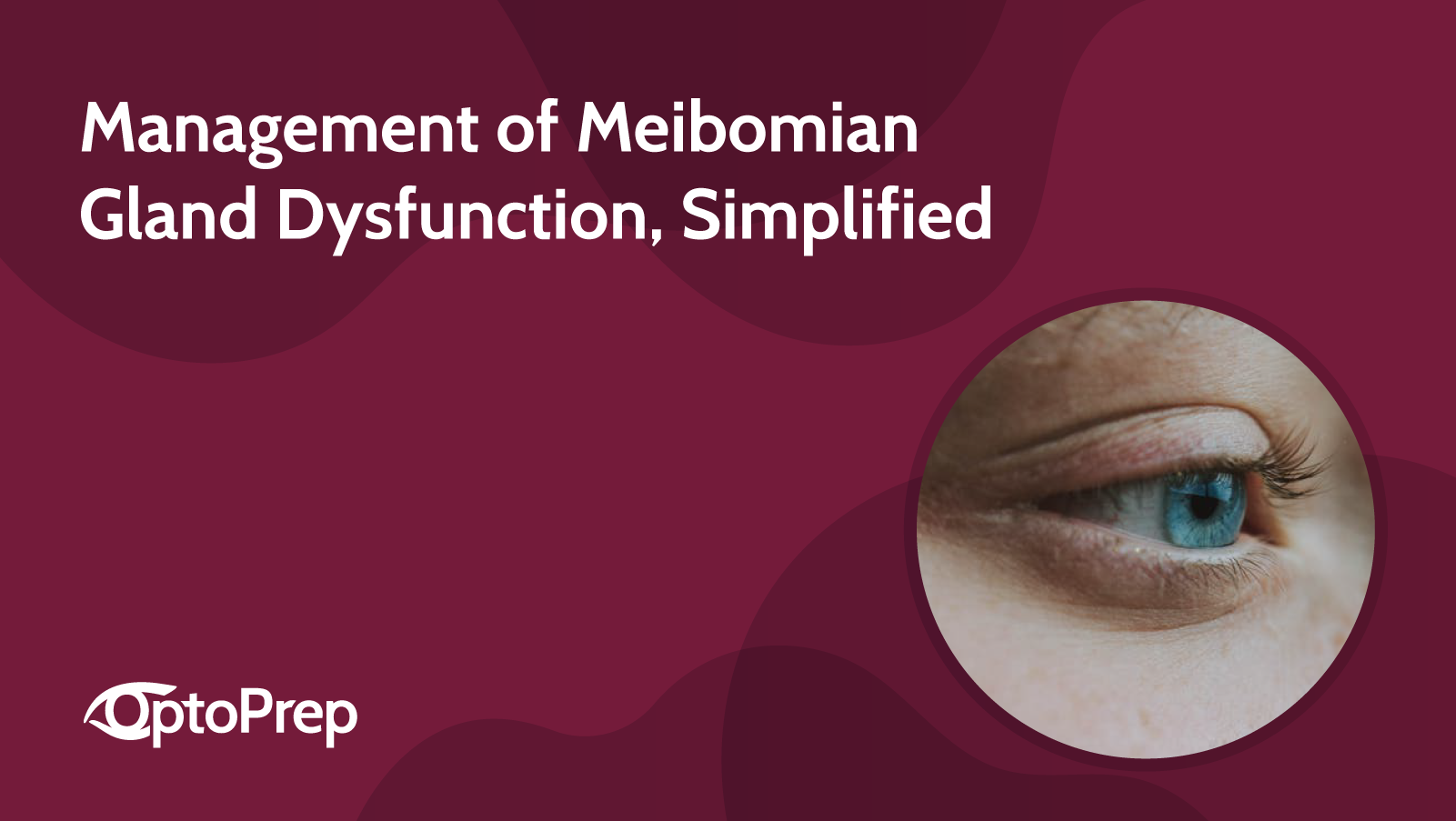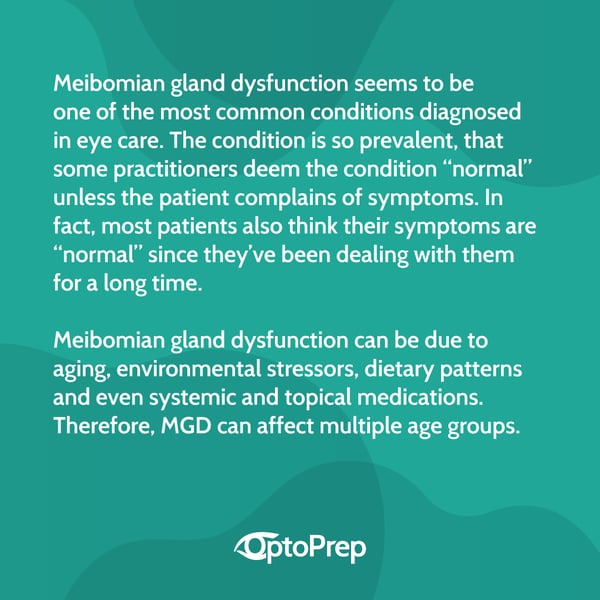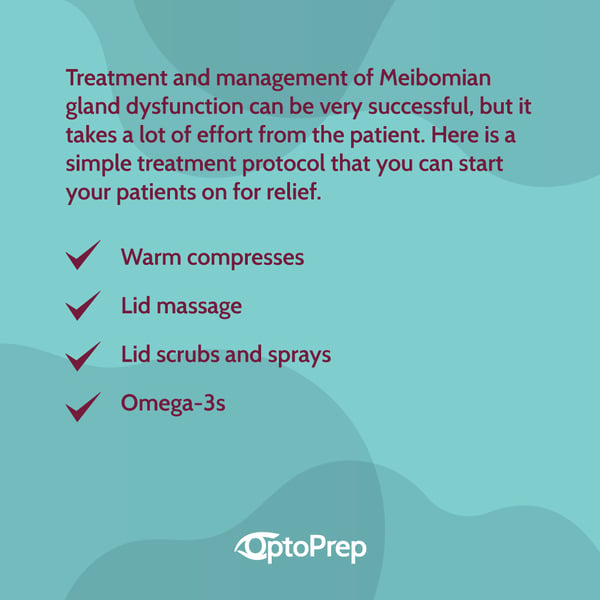
 Meibomian gland dysfunction seems to be one of the most common conditions diagnosed in eye care. The condition is so prevalent, that some practitioners deem the condition “normal” unless the patient complains of symptoms.
Meibomian gland dysfunction seems to be one of the most common conditions diagnosed in eye care. The condition is so prevalent, that some practitioners deem the condition “normal” unless the patient complains of symptoms.
In fact, most patients also think their symptoms are “normal” since they’ve been dealing with them for a long time.
So what is Meibomian gland dysfunction (also known as MGD) really? Though there are plenty of mechanisms that have been studied, the bottom line is that the Meibomian glands within the upper and lower eyelids are so damaged and disturbed that they don’t allow the lipid layer to be integrated into the tear film. This can be due to a variety of factors including epithelial hyperkeratinization of the lid margin which can lead to gland obstruction. This causes an instability of the tear film, and the remaining aqueous layer to evaporate, leaving behind a dry corneal surface and, of course, discomfort.

Meibomian gland dysfunction can be due to aging, environmental stressors, dietary patterns and even systemic and topical medications. Therefore, MGD can affect multiple age groups.
So what do patients complain about when MGD is the problem? The tricky part is, oftentimes they complain of nothing. In fact, most patients with MGD are asymptomatic. However, ignoring this asymptomatic process can lead to bigger problems down the line such as Meibomian gland atrophy, hordeola, and chalazia. However, those patients who do have symptoms might tell you their eyes feel dry and eyelids sometimes feel painful. Some also report foreign body sensation, similar to aqueous deficient dry eye.
Treatment and management of Meibomian gland dysfunction can be very successful, but it takes a lot of effort from the patient.

Here is a simple treatment protocol that you can start your patients on for relief:
- Warm compresses: Optimal heat of the lid margin can help liquefy the solid oils that are causing the clogging of the glands. Some people like to use a warm washcloth to apply a warm compress. This is usually fine if the washcloth is constantly run under hot water to keep the heat consistent. Otherwise, a microwavable warm compress mask is great at retaining consistent heat for several minutes. I always recommend wrapping the mask with a wet towel before microwaving. This way, you’ll be delivering moist heat and vapor to the glands for a more effective treatment. I recommend doing this every night before bed, and sometimes twice a day in severe cases.
- Lid massage: This part is very important after applying heat. After the glands are warmed up and the meibom is liquefied, use the fingertips to massage right underneath the eyelashes on the lower eyelids and right above the eyelashes on the upper eyelids. This will mobilize the oils and secrete them. Some patients will notice blur after doing this, always assure them that means they're doing it correctly! When the oil is released onto the ocular surface it can cause a temporary blur. This should be done every time after a warm compress.
- Lid Scrubs and Sprays: Keeping the lid margin clean and balanced is key in preventing keratinization of the lid margin. Lid scrubs can be very helpful and easy to keep the lid margin clean and bacteria-free. Though some practitioners recommend using baby shampoo, there are plenty of other formulations available on the market now that target the eyes specifically. I recommend using lid wipes, sprays, or foams that are found over the counter.
- Omega-3s: Of all the recommended treatments, Omega-3s will provide the most long-term relief. Omega-3 fatty acids improve the quality of all of the oils in the body, not only the oils within the Meibomian glands. Find a brand of Omega-3 that you like, do your research on safety and efficacy, and recommend that brand specifically to your patients. With so many formulations on the market, patients can get confused with what’s on drugstore shelves. With Omega-3s, it’s important to check where the oils are sourced from (usually fish) and levels of mercury. Flax seed oil is also a good alternative for those who have dietary restrictions to fish.
Now you have a simple treatment pattern for Meibomian gland dysfunction. Though it all seems easy, an accurate diagnosis and success with a simple treatment pattern can mean the world to your patient who may have been struggling with symptoms for years. For your more severe cases, you can always look into treatments such as Lipiflow® or Tearcare® to give you a more heavy-duty in-office treatment. However, it’s important to always remember that you don’t need very many fancy tools for an accurate initial diagnosis and treatment plan.
~ Dr. Amadian
